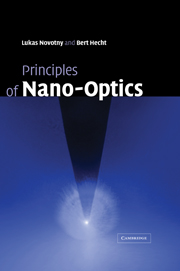Book contents
- Frontmatter
- Contents
- Preface
- 1 Introduction
- 2 Theoretical foundations
- 3 Propagation and focusing of optical fields
- 4 Spatial resolution and position accuracy
- 5 Nanoscale optical microscopy
- 6 Near-field optical probes
- 7 Probe–sample distance control
- 8 Light emission and optical interactions in nanoscale environments
- 9 Quantum emitters
- 10 Dipole emission near planar interfaces
- 11 Photonic crystals and resonators
- 12 Surface plasmons
- 13 Forces in confined fields
- 14 Fluctuation-induced interactions
- 15 Theoretical methods in nano-optics
- Appendix A Semianalytical derivation of the atomic polarizability
- Appendix B Spontaneous emission in the weak coupling regime
- Appendix C Fields of a dipole near a layered substrate
- Appendix D Far-field Green's functions
- Index
12 - Surface plasmons
Published online by Cambridge University Press: 05 June 2012
- Frontmatter
- Contents
- Preface
- 1 Introduction
- 2 Theoretical foundations
- 3 Propagation and focusing of optical fields
- 4 Spatial resolution and position accuracy
- 5 Nanoscale optical microscopy
- 6 Near-field optical probes
- 7 Probe–sample distance control
- 8 Light emission and optical interactions in nanoscale environments
- 9 Quantum emitters
- 10 Dipole emission near planar interfaces
- 11 Photonic crystals and resonators
- 12 Surface plasmons
- 13 Forces in confined fields
- 14 Fluctuation-induced interactions
- 15 Theoretical methods in nano-optics
- Appendix A Semianalytical derivation of the atomic polarizability
- Appendix B Spontaneous emission in the weak coupling regime
- Appendix C Fields of a dipole near a layered substrate
- Appendix D Far-field Green's functions
- Index
Summary
The interaction of metals with electromagnetic radiation is largely dictated by the free conduction electrons in the metal. According to the simple Drude model, the free electrons oscillate 180° out of phase relative to the driving electric field. As a consequence, most metals possess a negative dielectric constant at optical frequencies which causes, for example, a very high reflectivity. Furthermore, at optical frequencies the metal's free electron gas can sustain surface and volume charge density oscillations, called plasmon polaritons or plasmons with distinct resonance frequencies. The existence of plasmons is characteristic of the interaction of metal nanostructures with light. Similar behavior cannot be simply reproduced in other spectral ranges using the scale invariance of Maxwell's equations since the material parameters change considerably with frequency. Specifically, this means that model experiments with, for instance, microwaves and correspondingly larger metal structures cannot replace experiments with metal nanostructures at optical frequencies. The surface charge density oscillations associated with surface plasmons at the interface between a metal and a dielectric can give rise to strongly enhanced optical near-fields which are spatially confined near the metal surface. Similarly, if the electron gas is confined in three dimensions, as in the case of a small subwavelength-scale particle, the overall displacement of the electrons with respect to the positively charged lattice leads to a restoring force, which in turn gives rise to specific particle-plasmon resonances depending on the geometry of the particle.
- Type
- Chapter
- Information
- Principles of Nano-Optics , pp. 378 - 418Publisher: Cambridge University PressPrint publication year: 2006
- 13
- Cited by



